Tutorial & Guides
> Michaellauridsen
> Web Development
Simple Long Polling Example with JavaScript and jQuery. There are many reasons you might need to poll a web server.
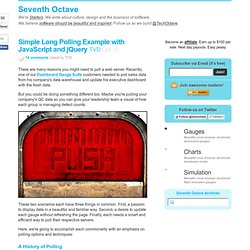
Recently, one of our Dashboard Gauge Suite customers needed to poll sales data from his company's data warehouse and update his executive dashboard with the fresh data. But you could be doing something different too. Maybe you're pulling your company's QC data so you can give your leadership team a visual of how each group is managing defect counts. These two scenarios each have three things in common. First, a passion to display data in a beautiful and familiar way.
Using Yeoman to scaffold out new websites—blog.ParkJi.co.uk. Recently I've been playing around with Yeoman, a web scaffolding tool.
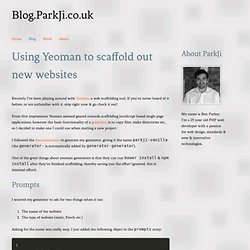
If you've never heard of it before, or are unfamiliar with it, stop right now & go check it out!
Improving Your Development Workflow with Yeoman. With so many great tools available to front-end web developers these days it can sometimes be difficult to understand how they all fit together.
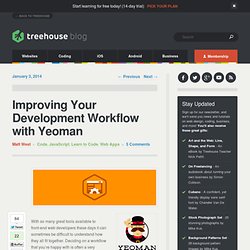
Deciding on a workflow that you’re happy with is often a very personal endeavour, but getting started isn’t always easy. Yeoman aims to solve this problem by defining a workflow for creating modern web applications, while at the same time mixing in many of the best practices that have evolved within the industry.
The Beginner's Guide to Ratchet: A Mobile Web App FrameworkTreehouse Blog. Ratchet is a front-end framework for building mobile web apps in HTML, CSS, and JavaScript.

Ratchet 2.0 was recently released, so it’s a good time to start learning how to build Ratchet apps. If you just want to see Ratchet in action, click this demo button on your mobile device (or enable touch events in your browser) to see what it looks like: See Demo (Mobile Only) Download Example Code About Ratchet Often it’s best to use responsive design for building websites that work across mobile, tablets, and desktop devices.
Tips for Writing Better Code. What is good code?
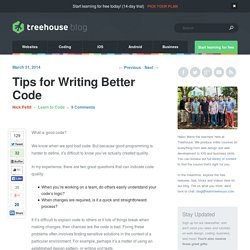
We know when we spot bad code. But because good programming is harder to define, it’s difficult to know you’ve actually created quality. In my experience, there are two great questions that can indicate code quality: When you’re working on a team, do others easily understand your code’s logic?
When changes are required, is it a quick and straightforward process?
How to Use The HTML5 Sectioning Elements. Articles for developers. Automating Your Front-end Workflow with Yeoman 1.0 (Addy Osmani)
Composite JS Apps: Regions And Region Managers. In my previous post on Composite JavaScript Apps, I introduced a few of the high level design ideas and implementation details that I have been using in an application that I’m building.

Since then, the requirements for that app have grown significantly and I’ve made more progress toward a better composite application design. Content Swapping My simple item management application started out with nothing more than these three regions on the screen: Once this was in place, though, a new requirement came along… a complex search with search results. To implement this, I needed to modify the application’s interface to swap the grid and add/edit form out and put in a search results screen instead. Microsoft Prism: Regions and Region Managers Several years ago, Microsoft released a framework for it’s WPF and Silverlight runtimes, called Prism. This pattern fits perfectly with the direction that my Backbone app is heading, so I decided to borrow the names and build my own version in JavaScript.
Improving Your Development Workflow with Yeoman. Client-Side vs. Server-Side Rendering.
Yesterday Twitter announced that it was moving away from client-side rendering back to server-side rendering in order to improve page load time.
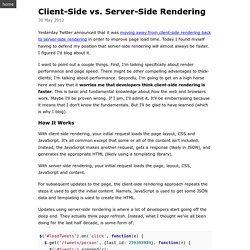
Today I found myself having to defend my position that server-side rendering will almost always be faster. I figured I'd blog about it. I want to point out a couple things. First, I'm talking specifically about render performance and page speed. There might be other compelling advantages to thick-clients; I'm talking about performance. How It Works With client-side rendering, your initial request loads the page layout, CSS and JavaScript. With server-side rendering, your initial request loads the page, layout, CSS, JavaScript and content.
Patterns For Large-Scale JavaScript Application Architecture. Today we're going to discuss an effective set of patterns for large-scale JavaScript application architecture.

The material is based on my talk of the same name, last presented at LondonJS and inspired by previous work by Nicholas Zakas.
Web Fundamentals. Frontend Masters Expert Web Development Training. Html5sql.js Home Page. Local Storage. You are here: Home Dive Into HTML5 Diving In Persistent local storage is one of the areas where native client applications have held an advantage over web applications.
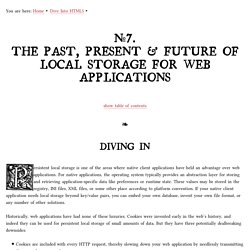
For native applications, the operating system typically provides an abstraction layer for storing and retrieving application-specific data like preferences or runtime state. These values may be stored in the registry, INI files, XML files, or some other place according to platform convention. If your native client application needs local storage beyond key/value pairs, you can embed your own database, invent your own file format, or any number of other solutions. Historically, web applications have had none of these luxuries.
What we really want is.









